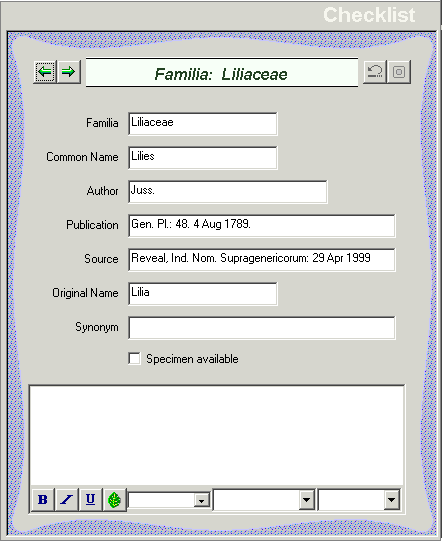
|
The Checklist view displays the details of an individual botanical
name entry. Here is where you can find information about a plant name.
These names may be at any level of the taxonomic hierarchy.
|

| Rank |
The rank within the hierarchy, for example, ordo,
familia, genus, species, and so forth. This level is shown just to
the left of the taxon name. |
| Taxon name |
The name of the entity. All names at the
rank of genus and above are unique. Names names below genus are
non-unique. |
| Common name |
One or more common names for this taxon
name. You may want to add your own common names to this field. |
| Author |
An abbreviation of the last name of the author of
this plant name. The author is the person who first validly
published a description of this plant name. This attribution is a
required part of the botanical name for botanists and other
scientists. It is not commonly applied to plant names vernacularly. |
| Publication |
A citation of the first publication of this name. |
| Source |
The Compleat Botanica's source of the author and
publication data. |
| Original name |
The name originally used for this item.
Validly published names are sometimes changed to conform with the
standards of the International Association of Plant Taxonomists
code. These rules require plants at certain levels of the hierarchy
to have certain name endings. For example, family names must end in
-aceae. |
| Synonym |
Other validly published names which synonymously refer to this item.
|
| Specimen available |
You may check this box to indicate that you have
a specimen of this type in your collection. All higher-level names
in the hierarchy are automatically checked for you. In this way you
can see the diversity of your plant collection. |
| Notes |
You may freely add notes about the plant name
here.
See What's possible with the notes area,
Adding cross references to specimen in the
notes area, and Limitations on the note
fields.
|
|
![]() Nomenclature used in The Compleat Botanica
Nomenclature used in The Compleat Botanica